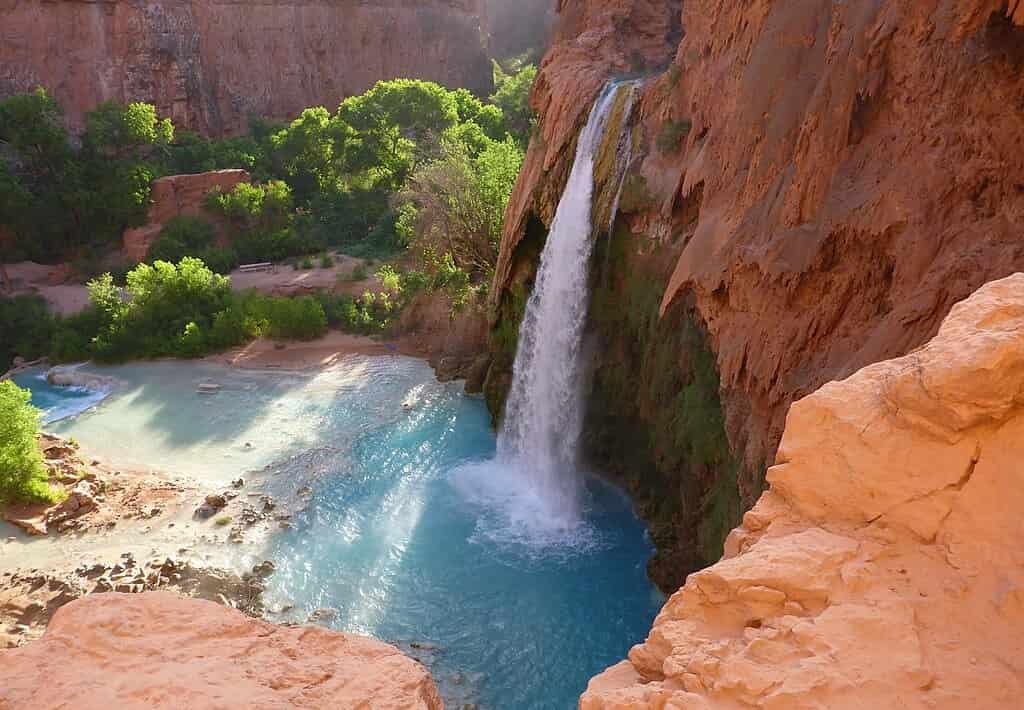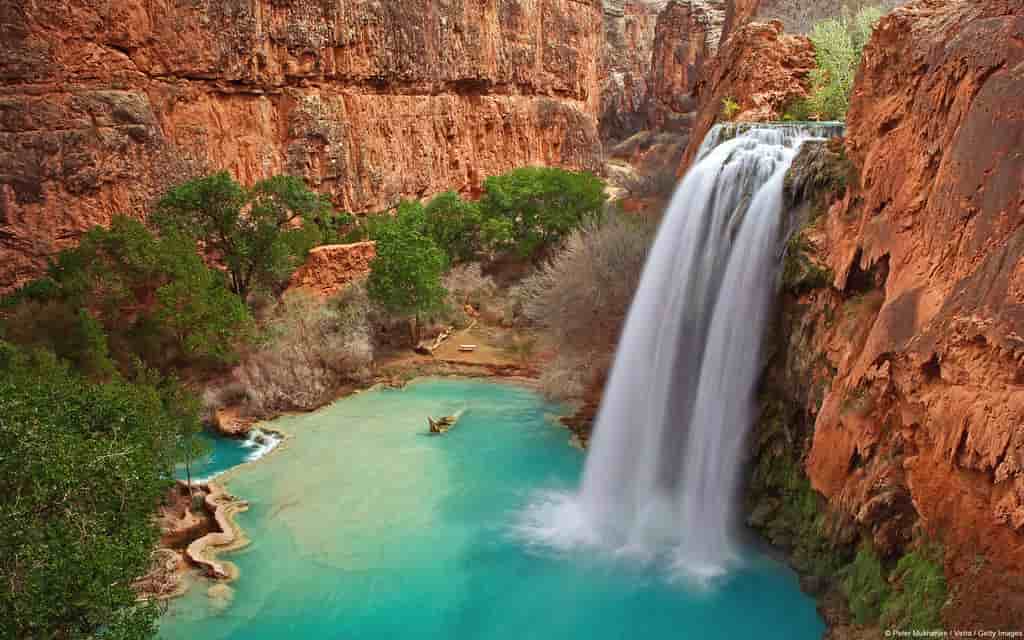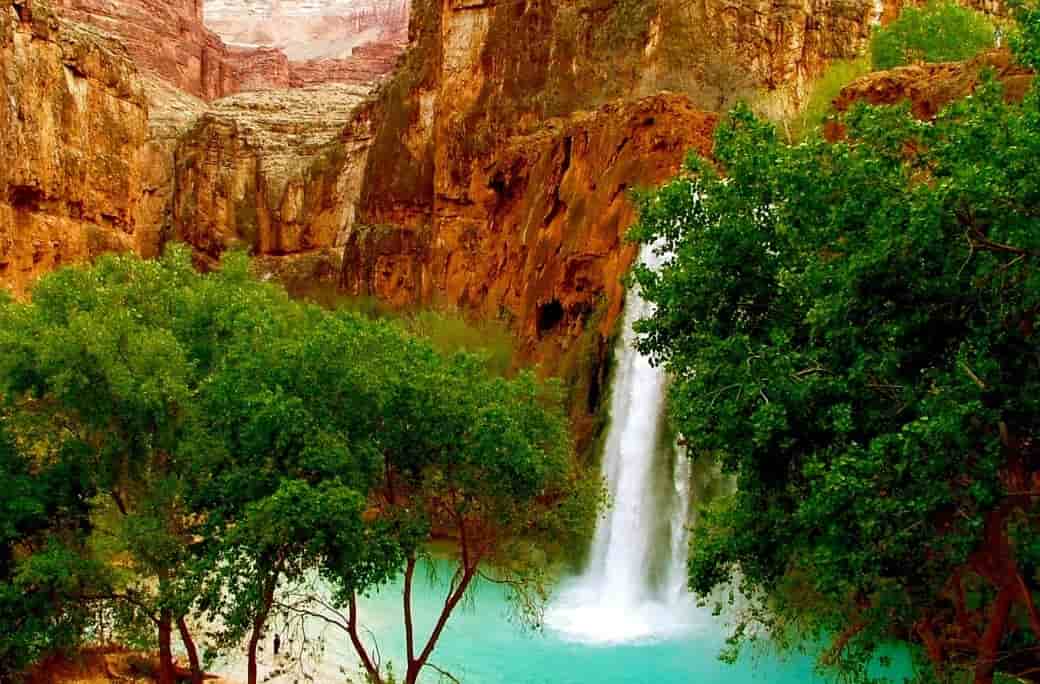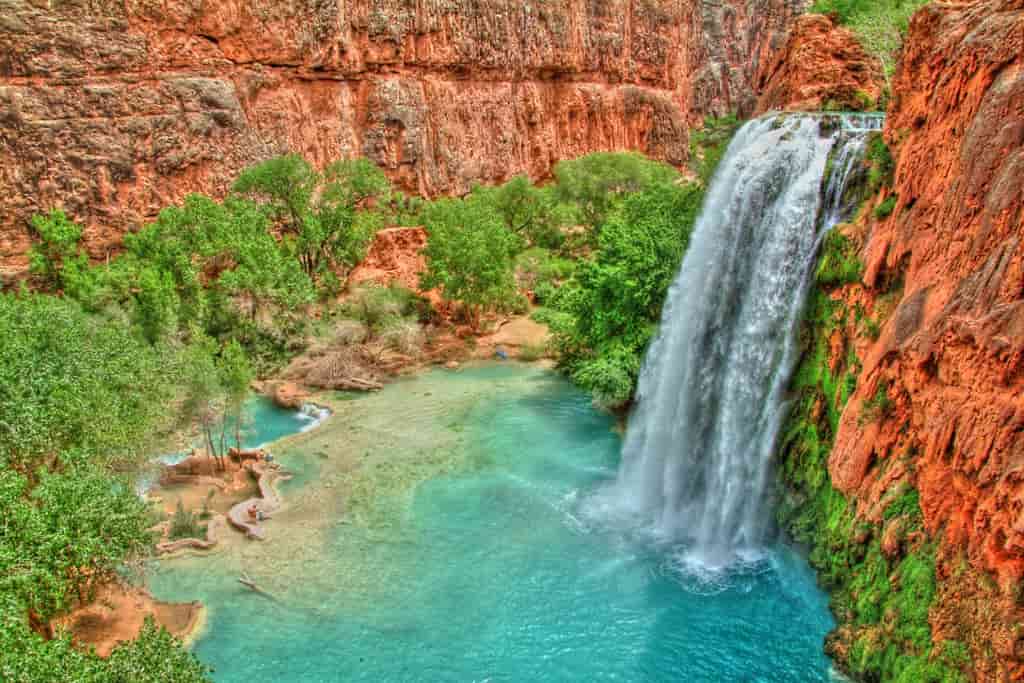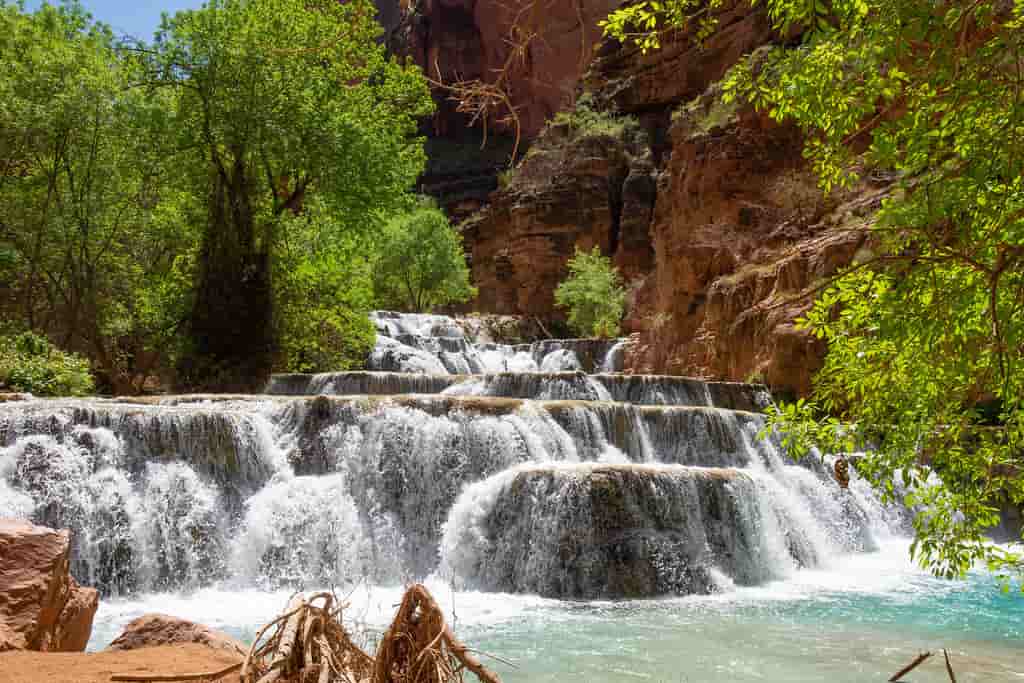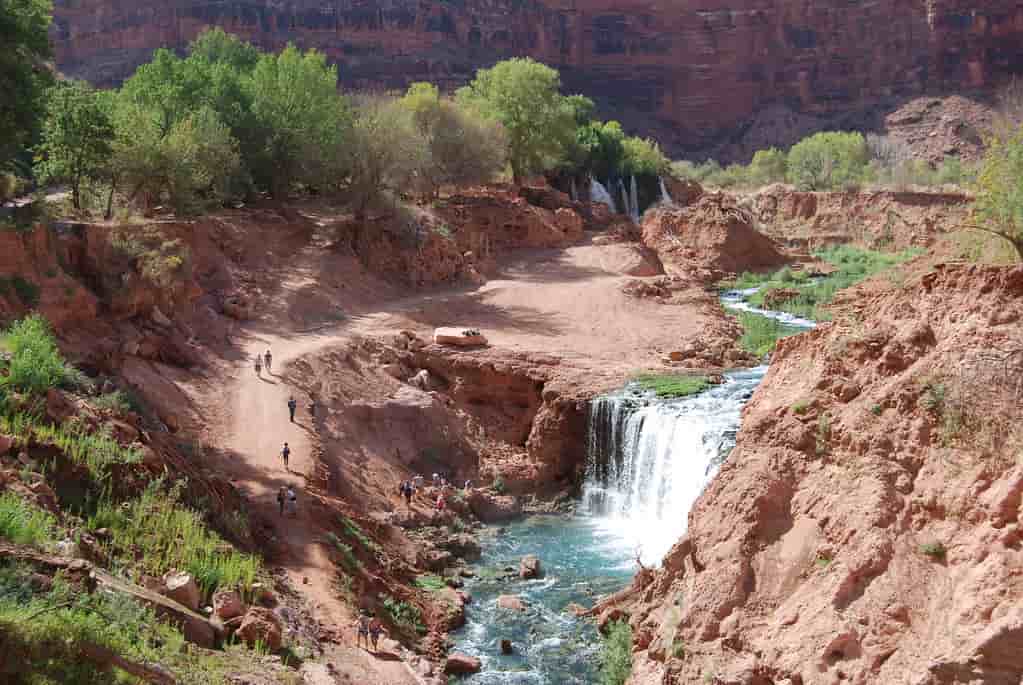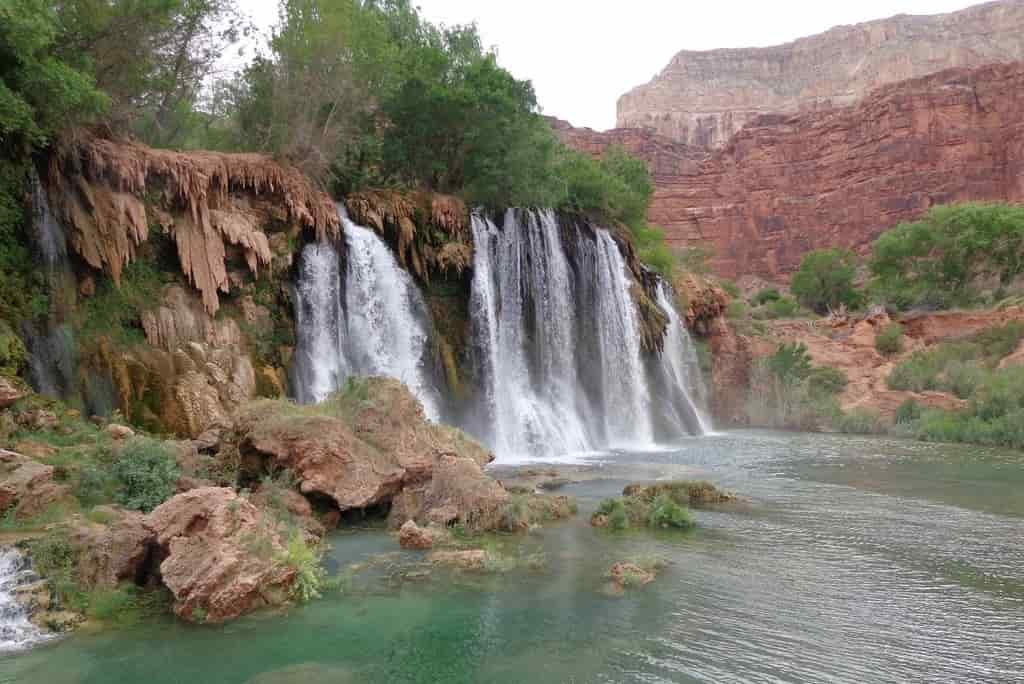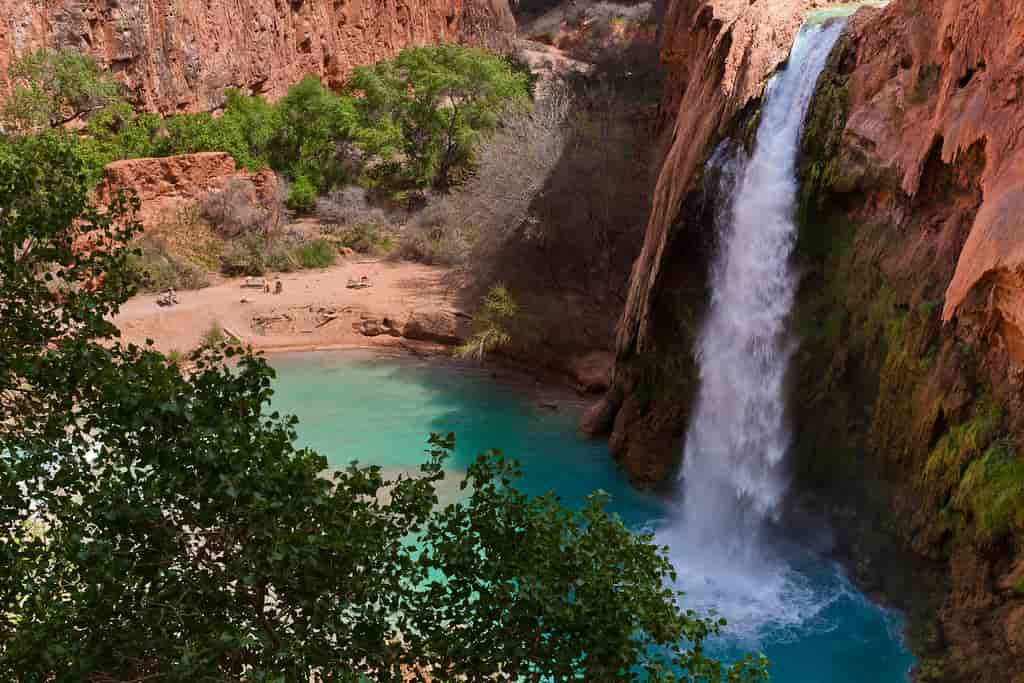Best time to visit Havasu Falls: Havasu Falls is a waterfall of Havasu Creek, nestled in the Grand Canyon, Arizona, United States. It is in the vicinity of Havasupai tribal lands. Havasu Falls is an extraordinary waterfall in the Havasupai Indian Reservation in Arizona USA, situated within the Grand Canyon National Park.
Vigorous blue water, discerned with striking red stones portrays the canyon with an ambience of utmost magnificence. A vast shore of sand and a superabundance of shady cottonwood trees make it an excellent place to have some relaxation.
The Havasupai tribe, who have taken the responsibility to look after the reservation, maintains a level of personal association with the water as well as the land.
Havasu Falls is found 1.5 miles (2.4 km) away from Supai. It is considered to be a very well-known and majorly visited fall by tourists among the varied falls along Havasu Creek. It consists of one central water source that falls over a 90-to-100-foot (27 to 30 m) standing cliff into a sequel of descent reservoirs.
There is no access to fresh drinking water from the trailhead parking area to the Supai Village. Backpackers are instructed to carry their water along with them.
Deciding on the right time to visit depends on several factors from individual convenience to weather patterns, and the distinctive nature of each season vests upon this innate wonder. To guide you in choosing the perfect time for your Havasu Falls experience, let’s embark on a journey through the calendar, unveiling the secrets of each month in this article.
Read more: 15 Best Cities to Visit In Colombia
How to get to Havasu Falls?
There are several routes to reach Havasu Falls. For passionate backpackers, hiking is a fun adventure. The start point to the track to Supai begins at Hualapai Hilltop (the Havasupai trailhead) which will lead you 10 miles down a route that can be considered somewhat mixed up.
A small reminder about the absence of assistance at Hualapai Hilltop; the closest services there are 106 km away in Peach Springs. Getting to the trailhead itself is a challenging task.
A more convenient choice for hiking is to put up with a guided horseback ride into the ravine from Hualapai Hilltop. Although being a more costly alternative in comparison to hiking, it takes far less struggle and will allow you to truly understand and experience the canyon like a local.
Camping or Lodging
There are two major alternatives for staying near Havasu Falls, which are: camping at the Supai Village campground or staying at the Havasupai Lodge. Camping offers a more natural experience in the wild and is normally more reasonable, while the lodge provides luxuries such as showers, laundry facilities, and more. Reservations are mandatory for both camping and lodging well in advance, as the area is restricted.
The Havasupai Lodge is 2 miles away from the falls. To your knowledge facilities are basic at both the lodge and the campsite. Although there is water at the campsite, you must still carry all your supplies and food along with you. There are unavailability of catering facilities at the lodge but food can be purchased in the local village.
Visiting Havasupai Falls & Permits
A startling raw phenomenon, Havasupai Falls is situated in the Grand Canyon. It is a famous destination point for many backpackers and photographers because of its turquoise waters and cascading falls. However, it’s vital to be knowledgeable about the permitting procedure before you plan your trip.
Everyone who wants to visit Havasupai Falls, which includes day trippers and overnight campers should get a permit in advance. It is important to schedule your trip and book your ticket as early as possible because the permits are sold out fast.
Campground permits cost $455 per individual for a 3-night minimum stay. Lodge rooms cost up to $2,277 per room for a 3-night minimum stay (each room can accommodate almost 4 visitors).
The trek to Havasupai Falls is a challenging task with a 10-mile round-trip decline into the canyon followed by an incline of the exact height. Make sure that you are in good physical condition before endeavouring this hike.
There are two campgrounds functional at Havasupai Falls: 1. Supai Village Campground and 2. Havasu Campground. Supai Village Campground is established near the trailhead, while Havasu Campground is situated near the waterfalls.
The only hotel choice open at Havasupai Falls for visitors is the Havasupai Lodge. It is nestled in Supai Village and offers essential amenities such as showers, laundry facilities, and a cafeteria.
Depending on the period of year the weather at Havasupai Falls can differ. It can be hot and dry in the summer and cold and icy at times of winter.
As said above, permits are sold out fast. Be certain to book your trip as early as feasible, particularly if you are trekking during the peak season like May-September. The trek to Havasupai Falls is challenging. Be foolproof that you are physically in a well-built state to face the challenges ahead and also load plenty of water, snacks, and sunscreen for the journey ahead.
Havasupai Falls is considered to be a holy site for the Havasupai Tribe, so be respectful of the surroundings and make sure not to leave any trash on your visit.
The Best Time to Visit Havasu Falls
Havasu Falls, a waterfall treasure nestled within the Grand Canyon’s depths, isn’t just a waterfall; it’s an immersive adventure. It is among the most prominent attractions in Arizona’s Grand Canyon. The scenic valley gives shelter to five waterfalls which are situated on Havasu Creek, within the Havasupai reservation area. It is close to the village of Supai, where the route to trek up to the Falls begins.
The best time to visit Havasu Falls depends on your choices. Spring (March-May) offers pleasant temperatures and experience. Summer (June-August) is the hottest period of the year, but the falls are at their maximum level and swimming is very enjoyable. However, this is likewise the busiest and most visited time of the year.
Fall (September-November) offers a relaxing atmosphere and comparatively less crowd, while winter (December-February) sees even fewer sightseers due to the possibility of snow-covered topography. However, the water can be colder and some facilities might be unavailable.
The best time of year to go hiking to Havasupai Falls is either at the onset of spring or at the end of fall. The best overall conditions can be encountered in March, April, May, September, October, and November. The valley is available for tourists throughout the year, but the weather is unpredictable during the summer and winter.
Fall’s Golden Embrace (October – November)
When summer’s heat reduces, autumn colours the ravine walls with multicoloured shades, transforming the landscape into a masterwork. The 8-mile hike down to the falls becomes more effortless the moment the temperature drops.
In summer the crowds slowly start to decline, giving a feeling of quietude craved by any individual amidst the towering ravine walls. The noontime sun will warm your skin as you dip into the water body to swim, a sense of peacefulness is welcome from nature. The evenings, besmeared with fiery sundowns, send moments of calm reflection by the cascading amazement.
Waterfalls can be surprising and one must remember that. Infrequent hail might test your spirit, and the temperature of water can drop a little. But for those seeking unity between pleasant weather and fewer crowds, fall’s golden embrace might be the perfect place.
Winter’s Serene Solitude (December – February)
As the world slumbers under a blanket of snow, Havasu Falls turns into a winter wonderland. Snow dyes the waterfalls with delicate appearances, and the towering ridges wear a crown of white. The crowds are at their absolute minimum, delivering a phenomenal insight into solitude.
The quietness, broken only by the gushing water, enables you to connect with the natural beauty of the niche on a deeper level. However, winter brings its challenges. The trek can be icy and dangerous, so the need for appropriate equipment and vigilance is essential.
The cold air edges with a chill and the water temperature stays constant at around 70°F, it’s a test even for the most daring hearts. Witnessing the falls illuminated with winter’s magic is an experience etched in one’s memory for eternity.
Spring’s Floral Fantasia (March – April)
As the world wakes up from its winter sleep, spring dyes the valley with vibrant wildflowers. Desert marigolds arise in a flare of yellow, contrasting with the deep-red prickly pear flowers. The air murmurs with the hymn to soothe the soul, and a renewed sense of significance fills the geography.
Hiking down the path laid with bright blossoms, each step sending out the sweet aroma of nature’s awakening will relieve anyone’s strangled heart. The waterfalls, no longer adorned with winter’s ice, roar with restored vitality, their turquoise splendidness is intensified by the blooming season. The days are extended, offering lots of time to explore the hidden coves and soak in the sun’s warmth.
However, spring also celebrates the return of crowds, albeit less than the summer rush. The water temperature remains cool while the periodic spring showers might add a piece of wonderment to your trip. If you enjoy mild temperatures, and vibrant landscapes, and can accept the company of fellow adventurers, spring’s floral fantasia might be your perfect choice.
Summer’s Sizzling Splash (May – September)
When the sun’s heat is at its peak, Havasu Falls turns into a sun-drenched oasis. The turquoise pools beckon with their refreshing embrace, promising a getaway from the heat of the scorching desert. Dense herbage blazes on the ravine walls, creating a vibrant contrast to the towering red rocks.
Diving into the cool, crystal-clear waters after a challenging hike and the sun’s warmth nourishing your skin as you bask on the travertine rocks will be on any hiker’s list. Days are lengthy, offering ample time for quests, swimming, and sponging the vibrant ambience. Being the peak season, the falls are crowded with sightseers, making it a festive and lively atmosphere.
It’s always good to be ready and equipped for the scorching heat, especially on the hike down. Crowds can be overwhelming, needing patience and planning. The level of water might go downward compared to other seasons, impacting the waterfalls’ majesty. If you desire warm weather, swimming in the turquoise pools, and can handle yourself in groups, summer’s sizzling splash might be your perfect option.
The History behind Havasupai Falls
Havasupai Falls is a canyon in the Havasupai tribal lands of the Grand Canyon, in Arizona. The Havasupai Falls vicinity comprises five major waterfalls that run from the Havasu Creek and wash over the Havasu Canyon. These are protected reservations and the grounds of the Havasupai tribe.
The tribe permits entry to tourists but it restricts crowds by not permitting day trips. Entry is also limited to permit holders. The Havasupai tribe has been living on these grounds for over eight hundred years.
The five Havasupai waterfalls have crystal-clear turquoise waters, except during the monsoon season. This colour of the water is due to the water staying below the ground for thousands of years, as well as due to the travertine that encircles the Falls. Havasu Creek also purifies mud from the waterfall pools, which helps in maintaining the blue-green colour.
There are many Havasupai Waterfalls
There are presently five waterfalls that together form the Havasupai Falls, but over the years this number has altered, and this is especially due to the floods that periodically affect the area.
1. Havasu Falls
This is among the most extensively visited waterfalls in Havasupai Falls and is likewise one of the most picturesque. Havasu fall is merely a brief walk away from the Havasupai Campgrounds and the crowd is lured by its enticing turquoise waters.
2. Beaver Falls
This waterfall can be found at the junction between Havasu Canyon and Beaver Canyon. It’s a site for both swimming and sightseeing, as it comprises many cascades. This trek can be difficult so it is always good to be prepared. It has barriers such as ladders and water that surpass your chest. Overall, it is a 14-mile round journey.
3. Mooney Falls
This fall is for the risk-taker, the descent to Mooney Falls is accomplished by taking hold of chains and walking down the ladders onto the mist of the falls. There’s an area that implicates getting on through old mining tunnels.
Due to the unstable current in its pool, Mooney Falls is unfit for swimming, nonetheless, it does show an impressive view to its visitors. Furthermore, it is the tallest waterfall in Havasupai and it is suggested that you take this hike.
4. Rock Falls
Rick Falls is one of the ‘new’ waterfalls that has re-emerged in the aftermath of the August 2008 flood. This cascade is simply a quick trek up from the Campgrounds, and it’s the most liked waterfall, especially by families. It’s a more hidden fall, therefore you will have to heed along the river to discover it.
5. New Navajo
New Navajo waterfall is also an aftermath of the 2008 flash flood which had dried up the original Navajo Falls. New Navajo can be easily reached by any hiker from the Campgrounds since it is located right next to Rock Falls. It has been considered as the most beautiful and most tropical-looking waterfall.
Things to Do
One can go hiking to the different cascades, such as Havasu Falls, Mooney Falls, and Navajo Falls, etc. Swim in the refreshing turquoise pools. Go for a guided tour and discover the history and civilization of the people of Havasupai.
For breathtaking scenery, trek to the periphery of the Grand Canyon. Stargaze under the clear night sky. In addition, one should make time to scour the area’s additional waterfalls while enjoying the surprise put forward by the Havasu Falls.
Three of them will be very easy to detect on your hike from Supai Village to the campground. Two additional waterfalls sit slightly north of the campground on Havasu Falls Trail.
Once sunk in at camp, most people prefer day hiking to the different falls. Merely a half-mile from the campground, the Havasu Falls Trail insists on shuffling down mist-covered ravine walls while grabbing onto a chain to get to the pools of Mooney Falls and go on to Beaver Falls. The adventurous hikers can head to all the routes to the Colorado River.
Things to bring
Havasu Falls is an isolated fall, so it’s better to expect a hike with some tint. Carry with yourself sunscreen, a hat, a first-aid kit, snacks, and plenty of water. There is non-availability of water on the track, and it is suggested that each person carry at least a gallon of water for themselves. Hiking poles are optional, although many hikers find these beneficial for the steep switchbacks.
It is suggested to bring a bathing suit, water shoes, a towel and a camera for your stay at the bottoms of the ravine. Pack a tent, sleeping backpack, sleeping pad, inflatable cushion and portable backpacking stove if you are camping. Carry edibles even if you are waiting at the Lodge.
Conclusion: Best time to visit Havasu Falls
Havasupai Falls is a well-recognized visitor destination for travellers who seek to explore the wonders of the Grand Canyon. Anyone who has visited Havasupai once definitely plans their next visit.
The best time to visit Havasu Falls is early spring or late fall in March, April, May, September, October, and November. These are the months when you will discover the best overall provisions for camping and hiking.
Havasupai Falls has great divergences in conditions between the seasons, and it presents beautiful views for beginner hikers as well as expert hikers. Visiting all five waterfalls requires a higher grade of hiking expertise.
However, Havasu Falls, Navajo Falls, and Rock Falls can be reached by anyone who is used to hiking. If you are tempted by the idea of hiking Havasupai Falls, make certain to keep an eye on the tickets and permits when reservations open. I hope you like this article, in this article, you have talked about the Best time to visit Havasu Falls as well as some interesting information.
FAQs: Best time to visit Havasu Falls
Q: Do I require a permit to visit Havasupai Falls?
A: Yes, everyone must have the permit, including day-trippers and campers.
Q: Where can I obtain a permit from?
A: Permits are obtainable on the official website of the Havasupai Tribe.
Q: How strenuous is the hike?
A: The hike is indeed challenging, with a steep 10-mile decline into the canyon observed by an equally demanding rise, it’s better to be ready for switchbacks, loose rocks, and heat.
Q: Where can I camp when at Havasupai?
A: There are two campgrounds. Supai Village Campground (closer to the trailhead) and Havasu Campground (closer to the falls).
Q: Can I drive to Havasupai Falls?
A: No. Havasupai Fall can only be accessed by trekking or helicopter which are again restricted and expensive.
Q: How much do the permits cost?
A: Campground permits cost around $455 per individual for a 3-night minimum visit while lodge rooms cost $2,277 per room for a 3-night minimum stay (each room can adjust up to 4 visitors).
Q: What luxuries are obtainable at the campgrounds?
A: Camping is basic, with vault restrooms, picnic tables, and fire rings. Carry all your reserves, including food, water, shelter, and toiletries.
